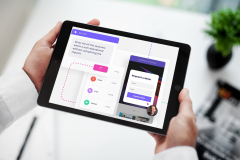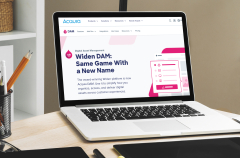PFL CMO Says B2B Companies See ‘Real Costs’ Of Inundating Buyers, Discusses Omnichannel Digital Experiences
- Written by Brian Anderson
- Published in Blog
 Customer experience has taken the main stage in the B2B community. Companies are pushing towards a customer-centric go-to-market strategy, but struggle with the repercussions of constant inundation from the marketing automation boom over the past decade.
Customer experience has taken the main stage in the B2B community. Companies are pushing towards a customer-centric go-to-market strategy, but struggle with the repercussions of constant inundation from the marketing automation boom over the past decade.
Progressive B2B companies have taken inspiration from their B2C counterparts to offer an omnichannel-orchestrated experience for their customers, according to Daniel Gaugler, CMO of the tactile marketing automation platform PFL. These solutions are making waves in the space for refreshing older marketing channels and finding ways to give buyers what they need — when they need it.
On the show floor at Adobe Summit, I chatted with Gaugler about the growing focus on customer experiences in the B2B marketplace, as well as how marketing teams are starting to understand the real costs of inundating prospective customers through easy go-to-market channels such as email. Read on to learn more.
Demand Gen Report: One of the main themes from the Adobe Summit was the continued development of personal, B2C-type customer experiences within the B2B marketplace. What are your thoughts on that trend and what is PFL’s stance on the topic?
Daniel Gaugler: I think that the customer experience matters more now than ever before. It's because you, the buyer, have more choices in your life. Digital marketing is awesome; it really has empowered brands to have different dimensions of their customer experience. However, the problem with anything that is effective, and maybe even underpriced, is you could argue that some digital marketing is overused. It's simple economics. We’re also seeing that it’s very one dimensional.
Thinking back on my own experience as a marketer, when I first started using AdWords — paying five, 10, 15 cents a click — you didn't have to be a good marketer to drive tremendous results because it was just so cheap. Email marketing has really gone through that same cycle. When we used to get the announcement from AOL that "you’ve got mail," you were excited! Nobody cheers when you get an email today. In fact, pretty much everybody is trying to block forms of communication to keep it filtered to the topics that they want to be a part of.
I like that the economics actually force marketers to think about the customer experience and make it better for the buyer. I also love to see that that's trickling into the digital realm, so marketers are improving that experience. Because at the end of the day, that improves their experience as a consumer and as a buyer.
For example, if I go to a trade show that cost me $10,000 and I get 100 leads, that's $100 a lead. Now, if I go home and send them an email that is irrelevant to them and they choose to block me, I have experienced a real cost. Someone who was engaged in my brand is now saying no, and that cost is bigger than people realize. Because that person didn’t just opt out for today, they opted out you’re your emails forever. They may re-opt-in at some point in time, but that is a real cost that marketers underestimate today. So, we can't be lax and not think about what the experience is. Whether we're doing digital or direct mail, there is a hard cost to abusing our buyers in terms of their attention to what they care about.
DGR: What is PFL’s current roadmap at the enterprise level, as tech ecosystems such as Marketo and Adobe start to consolidate?
Gaugler: I think there’s tremendous opportunity for us. We have the enterprise customers who are adopting our solution and looking at direct mail, particularly large digital brands, because they're looking for a way to differentiate on that customer experience.
I think this all leads to a better, easier and more robust ecosystem for the marketer. Adobe brings credible value to the Marketo ecosystem in terms of their analytics and data expertise. They've been doing this for the major retailers and major brands. B2C is ahead in many aspects compared to B2B in terms of how to target individuals and personalize at a very high level of scale. I'm looking forward to that application being brought into B2B.
For PFL, our focus is really on how we help those marketers deliver more value. There are two things: deliver value to their buyer and deliver more value to the organization. Our approach is that it's not just about what you send, it's also about the overall campaigns and success of the programs that you're building as a marketer. So, we're investing more and more into figuring out how we can help our customers make this jump to an omnichannel, multichannel world where digital, direct mail, in-person events and your sales teams are working in unison, rather than in silos.
DGR: What’s PFL’s biggest challenge to provide that more seamless, omnichannel B2B experience?
Gaugler: Speaking both as a marketer and as a vendor, the reality is that martech is too hard to use today. For most organizations, it takes a small army on a marketing team to run the tech that's required to do this correctly. The combination between Salesforce and marketing automation — whether it's Marketo, Adobe Campaigns, Salesforce Marketing Cloud or part of all these — all these different solutions require deep levels of expertise. This is nothing new. This is what we've seen for years as marketers became tech buyers. So, simplification for the user is the big opportunity.
I think as the ecosystem has grown really rapidly, all with different UIs and different philosophies, the acquisitions of Adobe and Salesforce and those big companies help bring that together. It’ll hopefully create a unified ecosystem that makes it easier for marketers to deliver.
DGR: What are your thoughts on the ongoing growth and investment in AI, and where do you see that playing a role in PFL and in your customers’ lives?
Gaugler: The biggest application we see right now today for AI is in identifying the “who” — how do I understand who I should market to? And then there’s also the “what” — what should I market to them with? AI coupled with a human is more powerful today than just AI on its own. AI isn’t replacing smart marketers, but it's complementary to smart marketers. It’s growing really rapidly in terms of improving who they target and then how they refine their messaging or relevance to those marketers.
I don't know of anyone doing this right now, but I think another huge application for AI is to understand what the potential impacts of a program are before you launch it. Right now, a lot of times you do your best to set a program up in your marketing automation platform and then cross your fingers, hoping you didn't miss anything. I think that's one of the places we will see markers be able to adopt AI early on.
DGR: What else is in store for PFL? Is there anything coming down the line from a product roadmap standpoint that we should be keeping an eye out for?
Gaugler: I think the biggest thing for our product roadmap is a deeper integration with the systems that marketers already use. We need to simplify and make that easier for them. The second is the combination of tools that support both marketing and sales.
As I mentioned earlier, everything is more effective when we work in unison together. Many people know about our integration with Marketo and our integration with Salesforce, but many don't know that those actually integrate together as well. So, the goal is to have your CRM and your marketing automation working together with the sales team. Not only will marketers then be able to launch programmatic campaigns, but they can also involve sales in that process to understand what content marketing is delivering. They can also prompt sales when they should send content or maybe need to apply personalization to that content to gain maximum results.

Brian Anderson
An avid B2B journalist with a knack for all things trendy in the POS, mobile and social space.
Related items
-
 Glassbox Insights Assistant Seeks To Uncover & Simplify In-Depth Digital Insights
Glassbox Insights Assistant Seeks To Uncover & Simplify In-Depth Digital Insights
-
 Glassbox Announces Generative AI Assistant To Enhance Digital Insight Access
Glassbox Announces Generative AI Assistant To Enhance Digital Insight Access
-
 6sense Names Latané Conant As Chief Revenue Officer
6sense Names Latané Conant As Chief Revenue Officer
-
 Acquia DAM Bolsters Search, Share & Analytics Capabilities
Acquia DAM Bolsters Search, Share & Analytics Capabilities
-
 3 Ways To Reduce Customer Acquisition Cost In A Recession
3 Ways To Reduce Customer Acquisition Cost In A Recession


